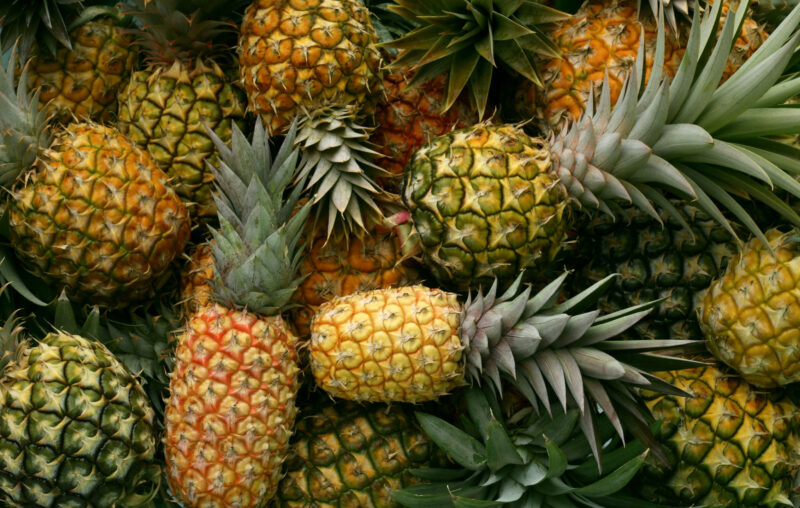
A few times a year, my local grocery store advertises whole, fresh pineapples for 99 cents. Yours probably does, too. Every time I see it, I can’t help but wonder at the progress of humanity.
Pineapple isn’t new. It was first cultivated by the Maya and Aztec peoples in South and Central America, millenia ago. Taínos brought pineapples with them when they migrated to the Caribbean, around 250 AD. Europeans and North Americans didn’t get to try that golden sweetness until colonization and the Columbian Exchange, with its global reshuffling of crops and cuisines. The same short span saw New-World foods delivered to European nations who would adopt them so thoroughly we can’t imagine it any other way: The Irish got their first potatoes; the Italians, their first tomatoes.
When pineapples were first imported to Europe and North America, they were astoundingly expensive. Shipped from the Caribbean, without the benefit of refrigeration, they were highly perishable and easily bruised. One pineapple could cost up to $8,000 (in modern dollars).
Pineapples were most often rented by the hour, they were so rare, expensive, and valued. They were given as gifts to important people, and used as centerpieces for lavish dinner parties or other events, where guests could marvel at their exotic strangeness. People carried the fruits around as ostentatious displays of status, or carved them into elaborate shapes. They were much too valuable to be eaten. Only when the flesh was thoroughly past ripe, after it had been hired out many times over, might someone get to actually taste the fruit.
Dishware, fabrics, furniture, and architecture soon bore pineapple motifs, so closely associated were they with wealth and luxury. Because a pineapple on your dinner table showed a hostess had spared no expense, its distinctive shape often appeared on items for guests (bedposts, hand towels, candlesticks, front doors), indicating a rich welcome.
The less-well-healed fruit enthusiast could sample pineapple products, preserved into more shelf-stable form near the equatorial plantation. Crystalized or dried pineapple, and liquor made from pineapple, began to enter middle-class cook books.
In temperate Europe, pineapple growing was more of an elitist hobby than true agriculture. Early attempts required tremendous effort and expense to produce even a handful of pineapples per season. Massive greenhouses, heated by stoves, were required to produce a specimen at Chelsea Garden in 1723. The palace horticulturists at Versaille were able to produce one ten years later. Over the next 70 years, various English aristocrats would build heated glass “pineries” on their rural estates, most with limited success in actually farming the fruit.
Pineapple production in the early 18th century moved to Jamaican plantations, at that time claimed by Britain, where enslaved Africans grew and harvested the fruit in bitterly cruel conditions.
Enterprise-level production was also successful in Hawaii, with costs of production kept low by cheaper land and labor, both at a price to native Hawaiians. Immigrants from Europe and Asia arrived, willing to plant and pick for fruit for export.
Pineapple doesn’t continue to ripen or gain sweetness after it is picked, like some other fruits, and picking them green (so they can make the journey) results in inferior taste. A shorter shipping journey enabled a larger percentage of the fruits to reach major markets in sellable conditions, giving some locales, including Hawaii, an added competitive advantage.
By the late-19th-century, someone was bound to bring cutting-edge technology of canning to where the pineapples grew. Several firms attempted it. Finally, the fruit could be delivered in a close-to-fresh form without the high rates of damage and spoilage. But a high US tariff on Hawiian goods kept canneries from turning a profit. The pioneer firms folded, one by one.
In 1898, the US annexed Hawaii, and shortly after a 22-year-year-old entrepreneur called James Dole arrived. He made himself a successful pineapple grower but in those conditions it was hard not to be. What made him the “Pineapple King” was his mechanization of the peeling and processing (supposedly his machines could churn through 100 pineapples every minute) and a more favorable US trade relationship than his predecessors enjoyed.
For a short time, Hawaii so dominated the market (and specifically, pineapple marketing) that we now call things “Hawaiian” as shorthand for “includes pineapple.” At its peak, Hawaii supplied 80 percent of the world’s pineapple; now that number is under 10 percent. The Dole Food Company remains one of the world’s largest growers of pineapple, but the original plantation has become a pineapple-themed tourist attraction. It is the second-most-visited site in a state where tourism is the top industry — the most-visited sight is the WWII monument at Pearl Harbor.
In the past 20 years, pineapple production has moved to places that offer the required mix of excellent climate and reasonable costs: Costa Rica, Indonesia, Thailand, and the Philippines. Though wages on plantations seem low to some, pineapple agriculture and processing jobs are generally the best option for those who take them (which is more than we can say for the colonial and enslaved past, when the fruit was counterintuitively many times more expensive).
The pineapple trade is now highly industrialized. Chemicals that ripen fruit — the same ones that ripe bananas emit — are added to crops a week before harvest. Refrigerated shipping containers on ships, planes, and trucks allow whole pineapples to be delivered fresh, worldwide, with little loss to bruising or rot. Grocery stores do a healthy trade in whole, fresh pineapples; cored and prepared pineapple; and canned and dried varieties. If you want a taste of pineapple today, almost anywhere in the world, you can get it for under a dollar.
Pineapples were once a supreme luxury item, which (through a combination of industrial process improvement, specialization, and relocation to regions with marginal advantages in pineapple growing) have become accessible to almost everyone. When past centuries’ most-iconic luxuries become commonplace and affordable, we always have specialization and market innovations to thank.


0 Comments